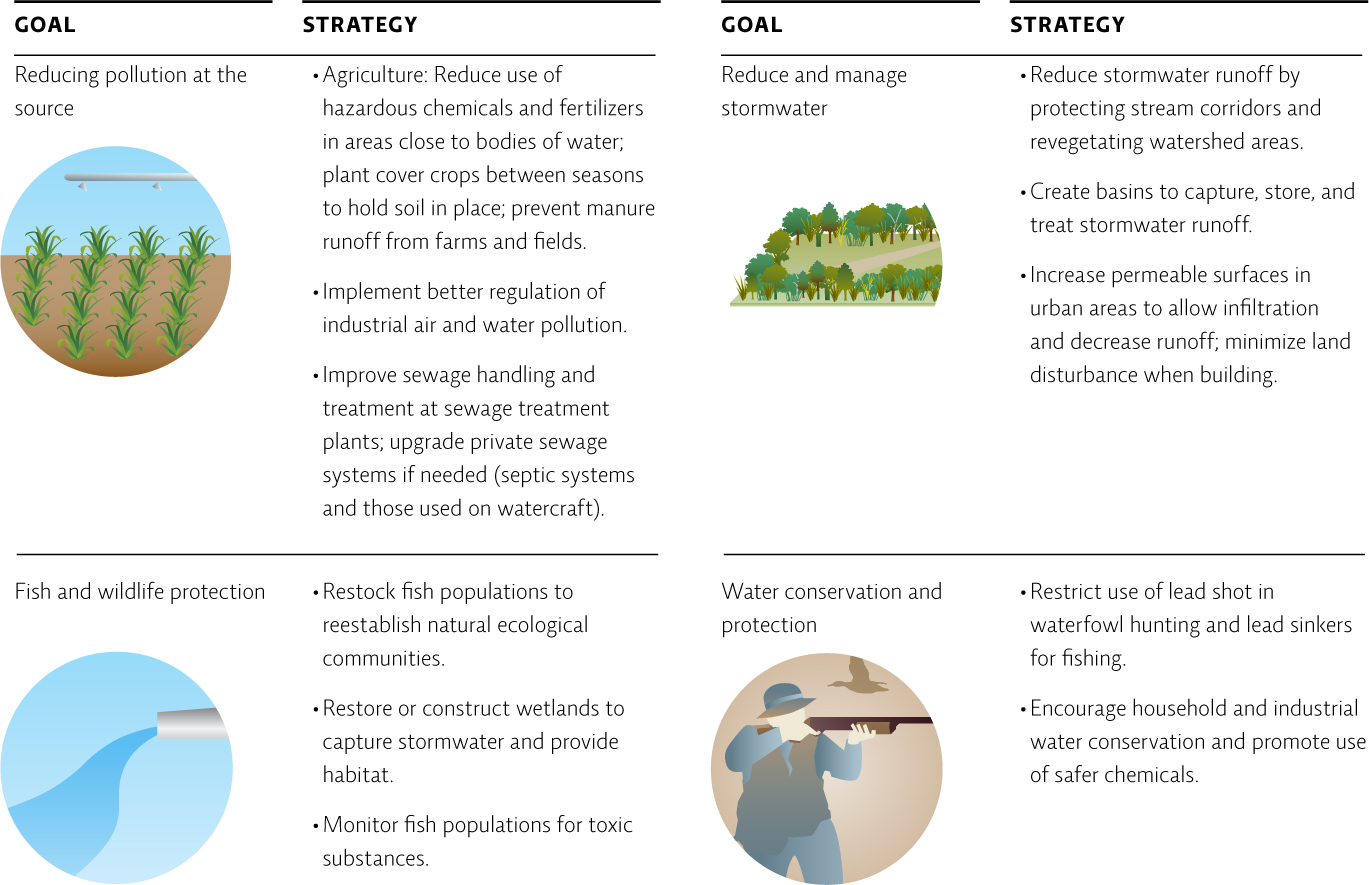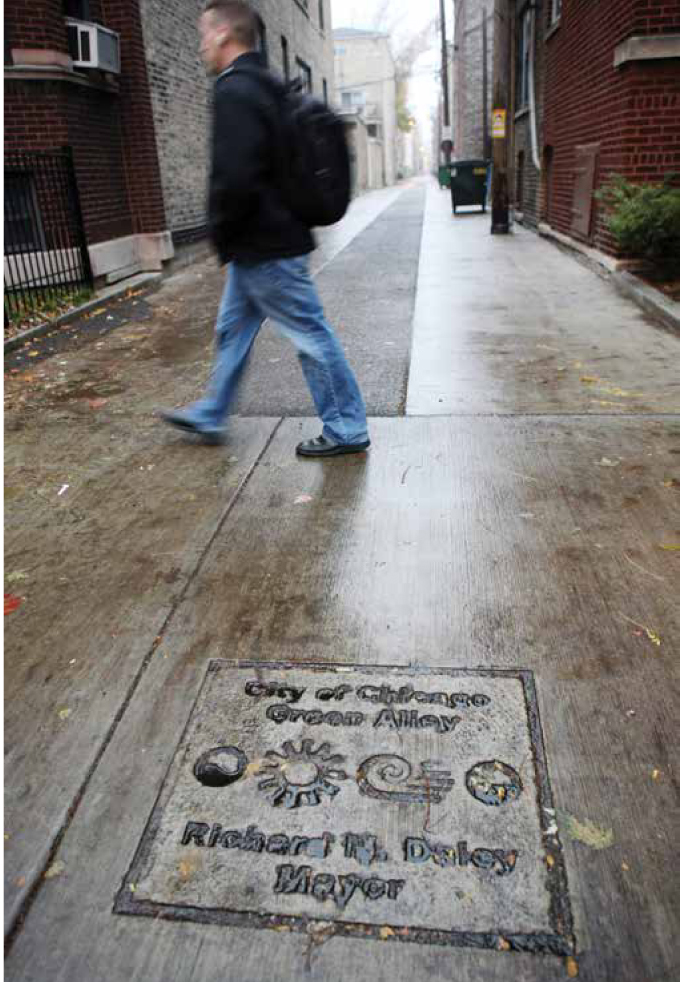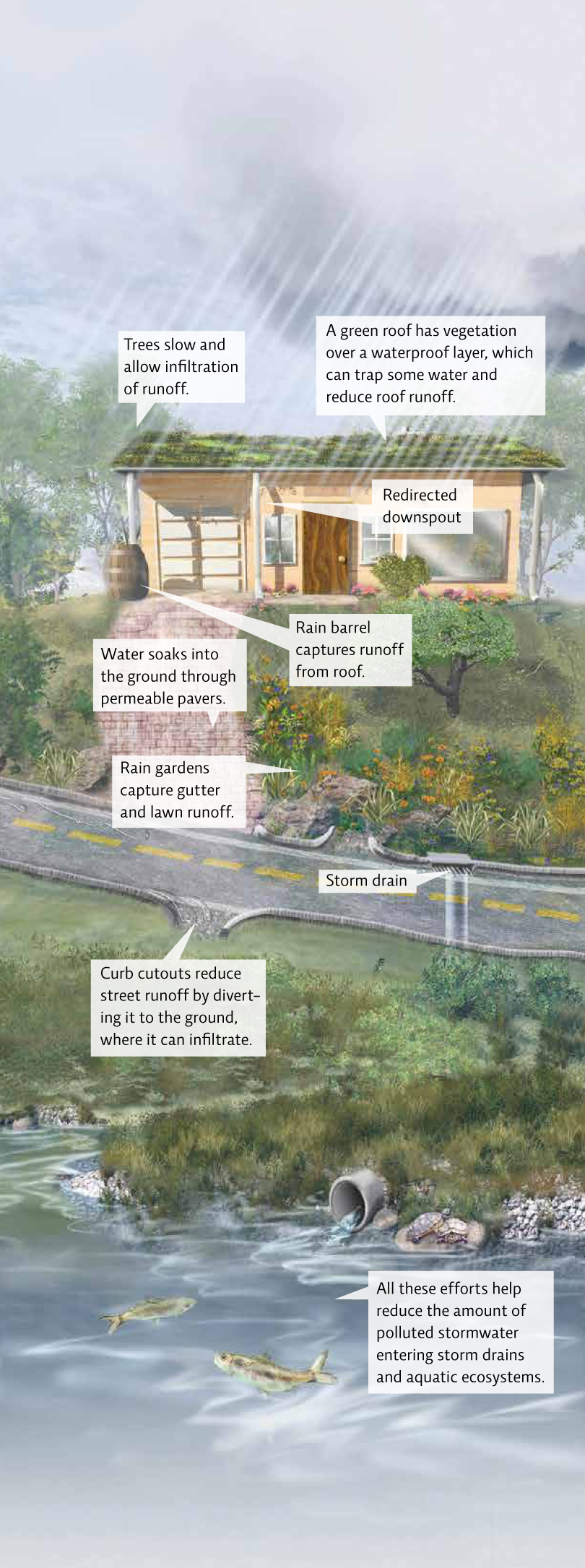16.7 Reducing pollution means reducing it at the source and preventing it from reaching the water.
Although officials took steps to reduce nutrient runoff from agricultural lands in previous decades, farmers everywhere can prevent chemicals and fertilizers from seeping into water bodies by using them judiciously, limiting toxic types, and planting cover crops during off-seasons, as exposed soil allows more runoff into streams during rain events. It’s often better to use fertilizers in warmer months, so it can be absorbed, rather than lying on top of frozen soil only to be washed away with the rain.
290
291
In fields around Lake Erie, many farmers have cordoned off areas for livestock that prevent them from wandering into streams, where they damage stream banks and bottoms, and pollute the water with feces and urine. Another key step they have taken is to restore riparian areas by vegetating buffer zones to slow runoff and give the rainwater time to soak into the ground. Trees at the water’s edge also provide cooling shade, which keeps water cooler and better able to hold oxygen.
In 1987, under the Great Lakes Water Quality Agreement, the U.S. and Canadian governments created Lakewide Management Plans for the Great Lakes, essentially plans of action to tackle the ongoing issues affecting each lake. Over the years, both governments have dedicated millions of dollars to preserving and cleaning up the lakes. Canada’s federal budget in 2010, for instance, allocated $16 million to cleaning up the most damaged areas.
Many wetlands along Lake Erie have been converted into agricultural fields, even though these wetlands act as natural filters for pollutants or nutrients. Now, as part of the Great Lakes Restoration Initiative, more than 120 hectares of unused farmland will be converted back into wetlands.
One of the most important steps officials took in the 1970s to clean up Lake Erie was to upgrade sewage treatment facilities. But now that the same problems have returned, it’s time to revisit those improvements to make sure they still meet the demands of the twenty-first century population, says Shear. More people have moved to the shores of western Lake Ontario, he says, which means more flow into sewage treatment plants. So pollution standards set in the 1970s may no longer suffice, he says. For instance, if facilities are allowed to release treated water containing less than 1 milligram of phosphorus per litre, the additional volume of water from the increased population means the total amount of phosphorus released will increase. “When more people move to an area, that increases the volume going to sewage treatment plants, so we have to lower the limits for pollutants even further.” [infographic 16.6]

292

Even though officials may be more aware of the problems water pollution can cause, these problems are far from being fully addressed. The city of Victoria dumped more than 120 million litres of raw sewage into the ocean every day in 2010; more than 181 million litres of untreated storm and wastewater are dumped every day into Halifax Harbour. Not surprisingly, both regions have reported massive dead zones as a result. But Canada’s “sickest” lake is Lake Winnipeg, which is now coated in a putrid mat of algae that is twice the size of Prince Edward Island. It’s even visible from space.
Steps can be taken in towns and cities to reduce sources of pollution and to decrease stormwater runoff. In suburban areas, lawns can be major non-point sources of nitrogen pollution if homeowners apply too much fertilizer. However, the grass also sequesters nitrogen because of its long growing season, preventing it from flowing to the nearby bodies of water. Homeowners are encouraged to limit fertilizer use on lawns and to plant native plants and grasses that do not need fertilizer. Planting a rain garden of water-tolerant plants in low-lying areas that tend to flood in rain events will also capture water and reduce runoff.
293
In urban areas, replacing some hard surfaces with porous surfaces such as green space or permeable pavers reduces runoff by allowing water to seep through. Green roofs can also help capture some rainwater and slow or prevent its release to the environment (see Chapter 26). [infographic 16.7]

The story of Lake Erie reveals that only constant vigilance and effort will keep the world’s waters clean. Complacency and cutting corners are not an option. Two years ago, Shear brought scientists visiting from Mexico to a sewage treatment plant in late winter to show them how phosphorus is removed before discharging the water into Lake Ontario. But the tanks and chemicals needed to treat the water were missing. Shear asked a technician where they were. “The technician said, ‘oh, we don’t use those in the winter to save money, because algae won’t grow in cold water.’” Shear’s jaw dropped. “Even if algae don’t grow in colder months, all those nutrients are pouring into the water—it’s like dumping fertilizer.” And when the water warms up in the spring, a huge burst of algae will follow.
We know the sources of water pollution, and we know how to address them, says Watson. It’s time to re-enact Lake Erie’s success story. “The Great Lakes’ contaminants are coming back to haunt us,” she says. “We’ve got a lot of work to do.”
Select references in this chapter:
Cruikshank, D.R. 1984. Whole lake chemical additions in the Experimental Lakes Area, 1969-1983. Fisheries and Marine Service Data Report, 449: iv + 23.
Jeffries, K., et al. 2008. Environmental Toxicology and Chemistry, 27(10): 2042-2052.
Michalak, A.M., et al. 2013. Proceedings of the National Academy of Sciences [Online], www.pnas.org/cgi/doi/10.1073/pnas.1216006110.
Watson, S.B., et al. 2008. Canadian Journal of Fisheries and Aquatic Sciences, 65(8): 1779-1796.
BRING IT HOME: PERSONAL CHOICES THAT HELP
We are facing not only shrinking supplies of easily accessible water, but also the potential degradation of this resource due to pollution. By changing products and modifying common practices, we can improve our water quality for years to come.
Individual Steps
 Read your community’s water quality report to see which pollutants are prevalent in your area.
Read your community’s water quality report to see which pollutants are prevalent in your area.
 Decrease your use of chemicals (fertilizers, pesticides, harsh cleaners, etc.) that will end up in the water supply. For alternatives to traditional yard chemicals, see safelawns.org.
Decrease your use of chemicals (fertilizers, pesticides, harsh cleaners, etc.) that will end up in the water supply. For alternatives to traditional yard chemicals, see safelawns.org.
 Always dispose of pet waste properly. In high quantities it acts as an oxygen-demanding waste and can also spread disease.
Always dispose of pet waste properly. In high quantities it acts as an oxygen-demanding waste and can also spread disease.
Group Action
 Marking storm drains with “Don’t Dump” symbols can remind people not to dump waste liquids down sewer drains. If the drains in your area are not marked, talk to city officials to see if you and other volunteers can mark them.
Marking storm drains with “Don’t Dump” symbols can remind people not to dump waste liquids down sewer drains. If the drains in your area are not marked, talk to city officials to see if you and other volunteers can mark them.
Policy Change
 Canada Water Week happens every March. Take steps every day to reduce your water pollution, and help raise awareness in March by writing a letter to your local newspaper outlining simple steps people can take to improve water quality.
Canada Water Week happens every March. Take steps every day to reduce your water pollution, and help raise awareness in March by writing a letter to your local newspaper outlining simple steps people can take to improve water quality.

294